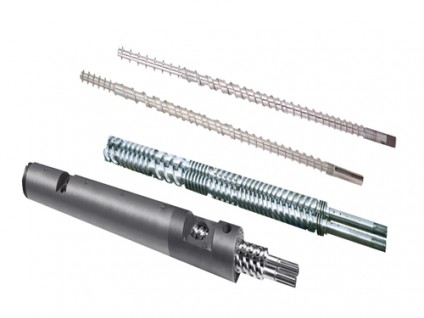Extruder barrel and screw
Extrusion is a manufacturing process used to shape molten plastic. Using internal friction and external heat provided by thermal resistance, the fed base material is converted into finished or semi-finished products, and the material is formed through an extrusion die (extrusion crosshead).
To form plastics (thermoplastics or thermosetting materials), you can use:
Single screw extruder, or
Twin screw extruder
Single screw extruder has two basic mechanical parts: extruder barrel and screw. Before being used in manufacturing applications, the extruder barrel and screw are surface hardened, and the nitriding depth is usually about 0.5 mm to obtain a screw hardness of about 800 HV and a barrel hardness of about 1000 HV.
Composition of Screw Barrel
The extruder barrel is made of the following materials:
Nitrided steel
Powder metallurgy steel, or
Bimetal is composed of two independent parts: the supporting substrate and the inner lining.
The bimetal is composed of two separate parts; the supporting substrate and the inner lining.
The extruder screw is made of the following materials:
Nitrided steel
Case hardened/or nitrided steel
Core hardened steel
Powder metallurgy steel, or
Special steel.
In addition to structural features and materials, extruder barrels can also be classified according to their and external characteristics or construction. As far as the outer surface is concerned, they can be smooth or machined.
There are advantages and disadvantages to using a barrel with a smooth exterior (that is, a barrel that is not machined or coated on the machine tool). We know that on this type of barrel, the placement of the thermal resistance can be cooled by a special fan, so it is obvious that this type of barrel has good heating capacity, but the cooling capacity is average. In fact, it is necessary to use a thermally coupled system of copper and aluminum fins to increase the thermal diffusivity during the cooling process, especially when processing materials that are sensitive to sudden changes in temperature. If the temperature rises by a few degrees, the processing performance will be compromised.
For example, an externally machined barrel can be finned from a solid steel cylinder, enabling it to be machined (Sampsistemi barrel). Compared with smooth barrels, machined barrels are much better in terms of heat dissipation, although they do have many disadvantages, including:
The local contact between the thermal resistance and the barrel cooling fins reduces the heat supply to the process.
The resistance life is slightly lower.
Higher barrel production costs.
In terms of internal geometry, the barrel may be:
Smooth, or
Slotting (only in the feed area)
The internal barrel groove near the extrusion feed area
Figure: 1 The internal tank near the feeding area
The capacity or melt output of the smooth barrel is lower than that of the trough barrel. In fact, the output of the grooved barrel is about 1.1 – 1.3 times higher than the output of the smooth barrel.
The output and process rules of the extruder are largely affected by the correct selection of grooves and motors and reduction gears. In fact, if the grooves are not handled properly, trying to reach a certain flow rate will generate excessive drive torque, causing the molten plastic to pulsate as it leaves the crosshead. Therefore, it is obvious that the friction between the material and the barrel increases with the increase of the barrel, and the difference in the friction between the material and the screw and the material and the barrel is also the same.
Design features of extruder screw
The extruder screw is a means of conveying materials during the extrusion process. It has the following parameters and design features:
Diameter, length and aspect ratio
Geometry (barrier flight, mixed part)
Pitch and helix angle
Compression ratio
Building materials and surface treatment
If need (water or oil) temperature adjustment axial hole
In the simplest configuration, the extruder screw is composed of three functional zones: a cylindrical feed zone, a melting or conical compression zone (with a set compression ratio) and a cylindrical metering zone (end of the screw). Then they may also have barrier flight or mixing zones.
The metering zone usually spans the last 3-5 diameters of the screw and is only used to pump the molten polymer forward in the same direction, ensuring that the correct pumping pressure transports it through the mold, through the conveyor and into the crosshead.
https://www.screwbarrel.co/








